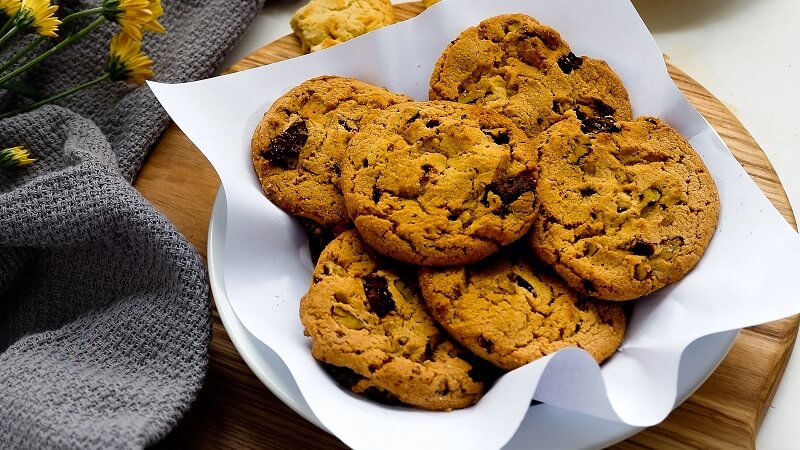
How To Make Homemade Pizza:Essential Tips and Precautions
Learn how to make homemade pizza with a simple, delicious recipe that rivals your favorite restaurant! This dough is a breeze to prepare and bakes

An embossed rolling pin is a must-have tool for any home baker. The embossed pattern on the roller adds beautiful designs and texture to cookies, pie crusts, and other baked goods. With proper care and maintenance, your embossed rolling pin can last for years.
In this comprehensive guide, we will walk through everything you need to know to get the most out of your embossed rolling pin, from baking tips to cleaning recommendations.

When shopping for an embossed rolling pin, there are a few key factors to consider:
Embossed rolling pins are commonly made from wood, marble, silicone, or plastic.
Wooden rolling pins are the most traditional option. Hardwoods like maple and walnut work best. The natural grains in the wood create a gripping texture to prevent sticking. Wood stays cold well, which helps keep the dough cool while rolling. With proper maintenance, a wood pin can last generations.
Marble is another excellent choice, especially for warm climates. The coolness of the natural stone prevents the dough from warming too quickly while rolling. Marble pins develop a patina over time but require little maintenance.
Silicone rolling pins have risen in popularity in recent years. Food-grade silicone provides a good grip and is naturally non-stick. Silicone pins are seamless for thorough cleaning and comfortable to grip. They tend to be lighter in weight than other materials.
Plastic pins are affordable and easy to find. Opt for solid plastic rather than hollow pins, which tend to warp more easily. Plastic has a smoother surface that requires extra flouring during use to prevent sticking.
Consider your climate, baking frequency, and budget when selecting a material. Wood and marble are best for frequent bakers, while silicone and plastic offer good lightweight options.
There are countless embossed pattern options to choose from – florals, hearts, leaves, latticework, and more! Select a versatile pattern that will pair well with the types of baked goods you plan to make.
Simple patterns like diamonds, dots, squares, and lattices work well for a variety of cookies and pie doughs. These understated designs add subtle texture without stealing the show.
Floral patterns featuring roses, sunflowers, and other flowers add delicate botanical beauty to baked goods. They work well for seasonal cookies, like Christmas tree cookies. Leaf patterns offer similar natural flair.
Intricate patterns like starbursts and paisleys take a bit more care to roll properly but create showstopping cookie designs. Likewise, swirls and curves lend visual motion and whimsy.
Geometric embossed designs like crisscrossing lines or intersecting triangles add modern style to your bakes. These bold prints work best on cookies and crackers.
Consider the occasions you bake for and choose a timeless embossed pattern that will suit a variety of holidays, seasons, and recipes. Simple patterns are the most consistent used for everyday baking projects.
Standard rolling pin sizes range from 8-10 inches long, which is sufficient for most home bakers. Mini pins around 5 inches long are also available for smaller baking projects.
For larger batches of cookies or pie dough, a longer pin around 12 inches makes quick work of rolling. Trokadero Rolling Pins and J.K. Adams make quality longer pins.
Choose a pin diameter of around 2 inches for the best leverage and control while rolling. Wider diameter pins tend to be heavier.
Make sure to select a size proportionate to the amount of dough you typically work with. Mini pins are perfect for small projects like decorating sugar cookies. A 10-inch standard size handles most standard baking needs. Invest in a longer pin if preparing large-yield recipes is your go-to.
Look for a pin with comfortable, easy-grip handles to make rolling effortless. Handles should be securely attached to the roller ends and well-balanced in weight.
Silicone handles provide the best grip and comfort, especially for those with hand pain like arthritis. They also absorb impact while rolling. French-style pins have slender handles that allow control, even pressure.
Wooden handles should be smoothly sanded, sealed, and shaped for an ergonomic grip. Avoid rough edges. American-style rolling pins have chunkier barrel handles well-suited to applying body weight during rolling.
No-handle rods require more control to roll evenly but can be used two-handed. Opt for pins with handles unless you require a very narrow roller for detailed work, like small fondant pieces.
Before you can create gorgeous embossed baked goods, the dough consistency must be just right. Here are tips for preparing dough that’s ready for imprinting:
For the best imprint, the dough should be well-chilled before rolling. Place dough in the refrigerator for at least 30 minutes up to a few hours before using your embossed pin. Longer chilling times may be needed for very soft or sticky doughs.
If working with a large batch of dough, divide it into smaller portions before chilling. Trying to imprint a giant dough log is tricky. Smaller chilled dough disks roll more evenly.
When mixing and kneading the dough, take care not to overwork it. Too much handling can cause the dough to become stiff and elastic. This leads to poor imprinting quality.
If the dough seems too sticky and elastic, sprinkle in a few extra tablespoons of flour until it reaches the desired pliable yet firm consistency for imprinting. Err on the drier side.
Have some all-purpose flour or cornstarch on hand to dust the pin and dough before rolling if needed. A light dusting between dough batches keeps imprints crisp.
Once you’ve selected the perfect embossed rolling pin and prepped your dough, it’s time to put your pin to use! Follow these tips as you roll and bake for gorgeous results:
Use a pastry brush to dust a very thin layer of flour across the rolling pin surface before each use. Avoid using too much flour or the imprint may be obscured.
Pie crust dough requires extra chilling time – at least 1 hour – to become workable for embossing. The higher fat content keeps it especially pliable. Refrigerate rolled crusts before baking.
Roll out dough in sections and work efficiently to prevent warming. Rotate pins often, so hands don’t warm one section excessively. Cool hands by rinsing in cold water if needed.
Distribute body weight evenly across the length of the pin while rolling. Rocking the pin back and forth applies uneven pressure that can distort embossed patterns.
If dough begins to stick while rolling, pause to reflour both the pin and dough surface. Use cornstarch for lighter dusting if the imprint appears obscured by flour.
Periodically lift and the edge of the dough away from the pin to check that the imprint is transferred fully and evenly before cutting shapes. Re-roll areas that need deeper imprinting.
After cutting out shapes, return imprinted dough portions to the fridge on a baking sheet lined with parchment. Allow 10-15 minutes to rechill before baking to “set” patterns.
Since embossed doughs are thicker in imprinted sections, keep an eye on even baking and extend the time if needed for the center to cook through.

Once you’ve mastered the basics, try some of these advanced embossed baking techniques for stunning results:
For very deep embossed patterns, imprint the dough then flip over and re-roll the other side. Chill again before cutting shapes. This creates detailed high-relief textures.
For a three-dimensional effect, roll out dough then imprint just the outer 1-inch perimeter by rolling the edges vertically along the pin. Leave the center smooth.
Use two contrasting embossed pin patterns in succession on the same dough by chilling and re-rolling. For example, roll with florals first, then lattice.
Dust fondant well with powdered sugar then firmly roll out to pick up the pin pattern. Use immediately before the impression fades. Best for simple designs.
For a subtle impression, place a sheet of parchment over the dough before rolling with the pin. The parchment will prevent sticking but allow some pattern transfer.
After embossing, use textured cookie cutters to cut out shapes. Cutters with scalloped or undercut edges work best to show off imprints.
Like any kitchen tool, proper cleaning and care are key to ensuring your embossed rolling pin lasts for years.
Embossed rolling pins should always be hand-washed to preserve the integrity of the material. Avoid soaking, harsh scrubbing, or dishwasher cleaning.
Use warm soapy water and a soft cloth or sponge. Rinse thoroughly. Dry immediately to prevent water damage.
Apply food-grade mineral oil or beeswax finish regularly to keep wood and marble pins looking their best. This maintains moisture balance and prevents drying.
Use a clean soft cloth to apply a thin layer of oil. Let soak for 10 minutes then thoroughly wipe pin dry with a clean towel.
Always dry embossed rolling pins thoroughly after washing. Allow the pin to air dry fully before storing it to prevent warping.
Use a towel to absorb excess water. Stand pins upright while drying so moisture doesn’t pool in imprints.
Store rolling pins horizontally on hooks or cradles to prevent bending and warping from gravity over time.
Keep pins away from heat and humidity, which can damage wood and marble. Store in a drawer or cupboard protected from direct sunlight.
Before each use, inspect rolling pins for any cracks, cloudiness, splintering damage or blurred imprints. Immediately discontinue the use of damaged pins.
Even when using proper techniques, you may occasionally encounter some problems when working with embossed rolling pins:
If the dough sticks to the rolling pin, it means insufficient flour was used. Generously flour the pin and re-chill the dough to get a clean release. Avoid rolling back and forth excessively over stuck areas.
If the imprint impression seems to fade over time, the pin may need reconditioning or replacing. Ensure the pin is thoroughly dried after each use. Oiling wood or marble pins regularly can help imprints last longer.
When pressure across the pin is uneven, imprint transfer will be inconsistent. Roll with steady, even pressure along the pin length. If one end imprints deeper, avoid applying more pressure there.
Store the pin properly to prevent warping. Wood pins can warp from moisture damage or temperature changes. Gently sanding and oiling help restore wavy wood pins. Cracked pins should be replaced.
Chilled dough that is too cold and firm can tear during imprinting. Allow chilled dough to rest at room temp briefly before rolling to improve pliability. Patch any tears before cutting shapes.
An embossed rolling pin doesn’t have to be limited to cookies, pie doughs, and pastries. Get creative with these unique ways to use your embossed pin:
Add flair to homemade pasta by imprinting ravioli, gnocchi, or spaetzle dough before cutting shapes. Try light floral patterns on herbed ricotta ravioli.
Imprint savory crackers like lavash or even pita dough before baking for a professional bakery look. Crisscross or geometric patterns work well.
Use your rolling pin to add a decorative indent along the tops of hand-shaped pan bread doughs like sandwich loaves before the final rise and baking for a rustic look.
For quick decorated sugar cookies, simply imprint the embossed design then add flood icing or royal icing to “color in” the impressed patterns in contrasting colors.
Impress dinner guests by embossing edible garlands, napkin rings, place cards, and table centerpieces made from sugar cookie dough or pie dough. Hang fluted ribbon drying racks and allow embossed dough shapes to dry uniformly.
Press sheets or shavings of chocolate onto the rolling pin to pick up the embossed design, then transfer onto iced cakes, brownies, rice crispy treats or tarts for added texture.
Make your own custom rolling pin. Use polymer clay or mill an eraser into your recipe name or logo. Press this handcrafted stamp around a wooden pin to emboss your brand into baked goods.
The possibilities are endless when you get creative with your embossed rolling pin! With proper care and techniques, this simple kitchen tool can take your baking to the next level or provide beautiful embossed textures on savory dishes.
Think beyond cookies and pies – the patterns pair nicely with everything from pasta to crackers and bread. Let your embossed pin inspire you to explore new baking and cooking creations.


Learn how to make homemade pizza with a simple, delicious recipe that rivals your favorite restaurant! This dough is a breeze to prepare and bakes

Have you ever felt like a screaming cat in the kitchen, especially when your biscuit attempts seem more like baking blunders? Well, it’s time to

Every baker knows that a rolling pin can be both a best friend and a formidable foe in the kitchen. Mastering the art of removing

As the holiday season approaches, the charm of Christmas decorating candy becomes irresistible. It’s not just about the sweetness; it’s about adding a personal touch

Learn how to make homemade pizza with a simple, delicious recipe that rivals your favorite restaurant! This dough is a breeze to prepare and bakes

Have you ever felt like a screaming cat in the kitchen, especially when your biscuit attempts seem more like baking blunders? Well, it’s time to

Every baker knows that a rolling pin can be both a best friend and a formidable foe in the kitchen. Mastering the art of removing

As the holiday season approaches, the charm of Christmas decorating candy becomes irresistible. It’s not just about the sweetness; it’s about adding a personal touch
Copyright © 2024 bakemasterrollingpin. All Rights Reserved.